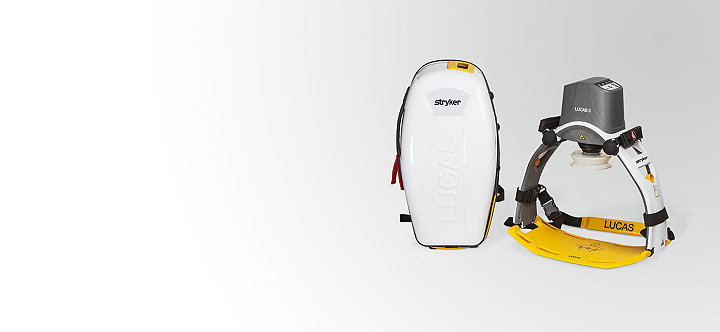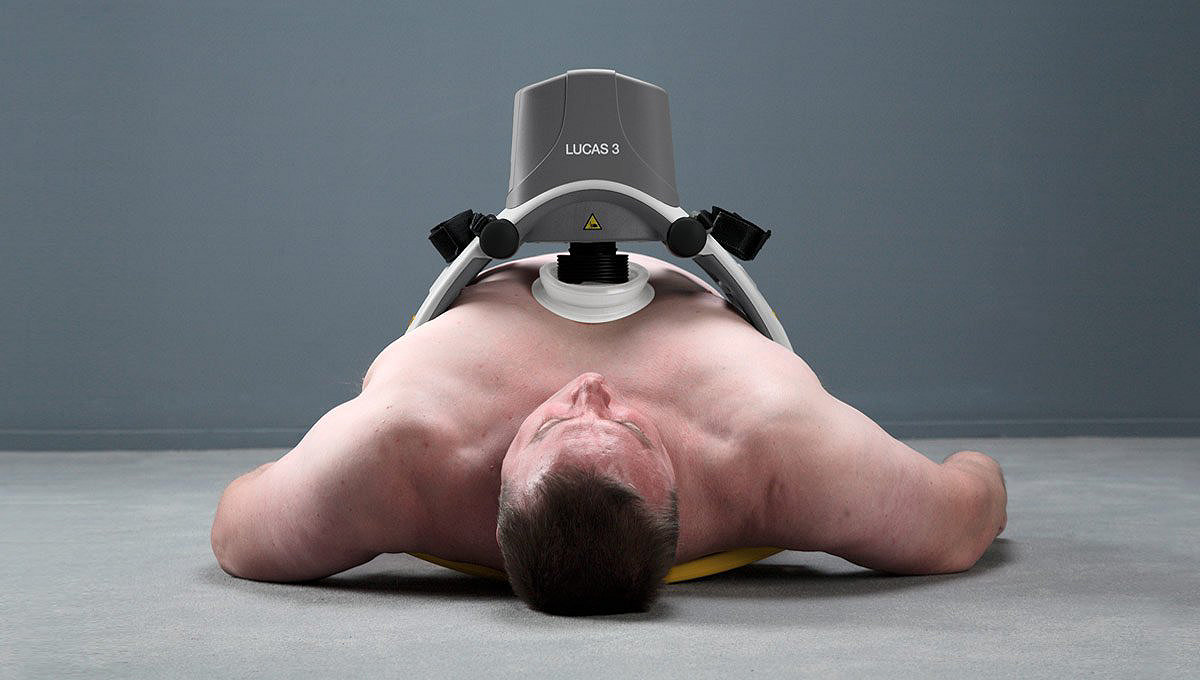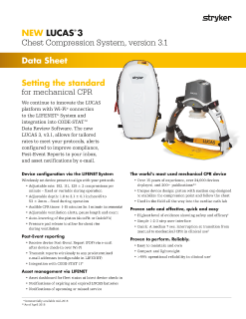LUCAS 3, v3.1 chest compression system
LUCAS 3, v3.1 chest compression system
Increase your power for advanced resuscitation
Deliver guidelines-consistent, high-quality chest compressions with less strain, micromanagement, and risk for the caregiver. The LUCAS chest compression system provides benefits both to the cardiac arrest patient and the resuscitation team.

Shown to improve CPR quality, on the move and over long durations1,2,3
The LUCAS device extends the reach of care by maintaining chest compressions during transport to advanced lifesaving therapies, including ECMO or PCI in the cath lab. It can improve provider safety, avoiding fatigue over long durations and reducing transport risks by allowing caregivers to sit belted. And it can increase the efficiency of caregiving teams, calming the scene and providing an extra pair of hands so they can focus on the patient and underlying conditions.
Key benefits
Help keep your team safeThe LUCAS device reduces the risk to the caregiver by facilitating safer transports, reducing x-ray exposure to the CPR provider during angiography and PCI, and lessening body strain and awkward work positions while delivering high-quality chest compressions, regardless of treatment surface or movement requirements.

Bridge to definitive care
Deliver guidelines-consistent chest compressions for as long as needed to allow difficult-to-resuscitate patients access to advanced lifesaving therapies. The LUCAS device helps bring life-saving interventions like ECMO/ECPR within reach of patients who don’t respond to CPR and defibrillation alone.

Improve CPR quality
The LUCAS device provides high quality guidelines-consistent chest compressions while helping to prevent caregiver fatigue, variation in CPR quality and CPR related injuries in healthcare providers.1,3,9
The LUCAS device has demonstrated increased blood flow to the brain4,5 and achieved higher EtCO2 values compared to manual compressions.6,7

Enhance team efficiency
Calm chaotic scenes and enable caregivers to focus their skills and judgement where it matters most. Relying on LUCAS to provide guidelines-consistent high-quality CPR allows you to focus on what’s important; life-saving interventions, speedy diagnosis and treatment of underlying conditions.
Video
________________
See LUCAS in action
"If someone had told me about an 8-hour cardiac arrest. I wouldn't have believed it. But this truly happened."
– Alessandro Forti, MD
HEMS Head Coordinator, Italy
Key features
LUCAS 3How the LUCAS 3 chest compression system enhances your power

Deploy easily and quickly
- Low-profile back plate for fast, efficient patient application
- Spacious support structure accommodates larger patients
- A median interruption time of 7 seconds when transitioning from manual to mechanical CPR during clinical use8
- Straps secure patient arms and device during transport

Configure to your protocols**
- Configure compression rate, depth, ratio and alerts to your protocols via wireless LIFENET connectivity
- Adjustable ventilation alerts, pause length and count
- Timer to remind rhythm and pulse checks
- Set auto-lowering and pressure pad parameters to your preferences

Easily access and share post-event data**
- Make QI/QA documentation faster and easier with emailed post-event reports
- Connect wirelessly via Bluetooth and WiFi to the LIFENET System
- Easy-access LUCAS device data enables productive post-event review
- Integrate with CODE-STAT 11 data review software

Easy to store and carry
- Battery operation lets the LUCAS 3 go anywhere
- Easy to use with a simple 1-2-3 user interface
- Lightweight and compact carrying case includes a window for quick battery checks
- External power supply enables prolonged operation and charging
- Easy to clean, with disposable suction cup on compression piston

Make asset management easier**
- Easily confirm device or fleet status via LIFENET connectivity
- Receive battery age notifications and upcoming/missed service
** LUCAS 3, version 3.1, LIFENET and CODESTAT are available in major markets. Please contact your local Stryker representative for more information about LUCAS and data connectivity.
Take the next step
Want to talk to your Sales Representative? Please complete the form below and we’ll connect you with your local representative.
When you invest in our lifesaving devices and data products, you are buying more than quality design and manufacturing—you’re also buying our unrivaled commitment to customer service and support.
ProCare services
Our excellent field service team stands beside you to make sure your lifesaving devices are ready when you need them. Highly experienced, our field service team knows to use, care for, maintain and repair your device better than anyone, giving your devices the longest possible life.
Technical support
We offer one of the largest networks of technical service representatives in the industry. We’ll work with you to quickly assess any issues and find the best solution.

Training and education
Comprehensive training is important for the optimal use of the LUCAS. Classroom-based, hands-on training resources, online device training with films and tests, and customized programs all help you start using it quickly and with maximum effectiveness.
Related products
LIFEPAK 15 monitor/defibrillator
Rely on the LIFEPAK 15 monitor/defibrillator for the confidence you need in emergencies and the highest available escalating energy, up to 360 joules (360J).
Learn moreLIFENET System
The LIFENET System is a comprehensive cloud-based platform that seamlessly manages and delivers patient information and device data that EMS and hospital teams need to work together effectively.
Learn moreCODE-STAT data review software
Turn your passion for saving lives into targeted improvements — CODE-STAT data review software and service lets you easily understand team performance immediately after response.
Learn moreSources
1. Putzer G, Braun P, Zimmerman A, et al. LUCAS compared to manual cardiopulmonary resuscitation is more effective during helicopter rescue–a prospective, randomized, cross-over manikin study. Am J Emerg Med.2013 Feb;31(2):384-9.
2. Gyory R, Buchle S, Rodgers D, et al. The efficacy of LUCAS in prehospital cardiac arrest scenarios: A crossover mannequin study. West J Emerg Med. 2017;18(3):437-445.
3. Olasveengen TM, Wik L, Steen PA. Quality of cardiopulmonary resuscitation before and during transport in out-of-hospital cardiac arrest. Resuscitation. 2008;76(2):185-90.
4. Carmona Jiménez F, Padró PP, García AS, et al.. Cerebral flow improvement during CPR with LUCAS, measured by Doppler. Resuscitation. 2011, 82S1:30, AP090. [Also published in a longer version, in Spanish with English abstract, in Emergencias. 2012;24:47-49].
5. Rubertsson S, Karlsten R.Increased cortical cerebral blood flow with LUCAS; a new device for mechanical chest compressions compared to standard external compressions during experimental cardiopulmonary resuscitation. Resuscitation 2005:65(3);357-363
6. Axelsson C, Karlsson T, Axelsson A, et al. Mechanical active compression-decompression cardiopulmonary resuscitation (ACD-CPR) versus manual CPR according to pressure of end tidal carbon dioxide (PETCO2) during CPR in out-of-hospital cardiac arrest (OHCA). Resuscitation. 2009, 80(10):1099-1103.
7. Chandler P, Ibrahim M. AS099. Manual chest compressions versus LUCAS 2 – A comparative study of end-tidal carbon dioxide levels during in-hospital resuscitation. Resuscitation. 2017, 118 (suppl 1):e41. Oral presentation.
8. Levy M, Yost D, Walker R, et al., A quality improvement initiative to optimize use of a mechanical chest compression device within a high-performance CPR approach to out-of-hospital cardiac arrest resuscitation. Resuscitation. 2015;92:32-37
9. Rubertsson S, Lindgren E, Smekal, D et al. Mechanical chest compressions and simultaneous defibrillation vs conventional cardiopulmonary resuscitation in out-of-hospital cardiac arrest. The LINC randomized trial. JAMA. 2013;311(1):53-61.
This document is intended solely for the use of healthcare professionals. A healthcare professional must always rely on his or her own professional clinical judgment when deciding whether to use a particular product when treating a particular patient. Stryker does not dispense medical advice and recommends that healthcare professionals be trained in the use of any particular product before using it.
The information presented is intended to demonstrate Stryker’s product offerings. A healthcare professional must always refer to operating instructions for complete directions for use indications, contraindications, warnings, cautions, and potential adverse events, before using any of Stryker’s products. Products may not be available in all markets because product availability is subject to the regulatory and/or medical practices in individual markets. Please contact your representative if you have questions about the availability of Stryker’s products in your area. Specifications subject to change without notice. The products depicted are CE marked in accordance with applicable EU Regulations and Directives.
Stryker Corporation or its divisions or other corporate affiliated entities own, use or have applied for the following trademarks or service marks: LIFEPAK, LIFENET, LUCAS, HealthEMS, RevNet, CODE-STAT, Physio-Control, HeartSine, samaritan, LIFEPAK CR, TrueCPR, REDI-CHARGE, QUIK-COMBO, EDGE, cprINSIGHT, ClearVoice, QUIK-STEP, LIFEPAK TOUGH, HomeSolutions.net, RELI, REDI-PAK, Shock Advisory System, LIFELINKcentral. All other trademarks are trademarks of their respective owners or holder. The yellow and black color scheme is a registered trademark of Stryker Corporation.
LIFEPAK devices: CE Class IIb (0123)
HeartSine device: CE Class IIb (0123)
LUCAS device: CE Class IIb (2460)
EC REP: Stryker European Operations Limited | Anngrove, IDA Business & Technology Park | Carrigtwohill, Co. Cork, T45 HX08 | Ireland
M0000007484 REV AA









